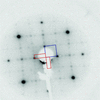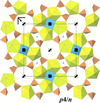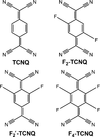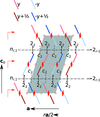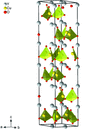issue contents
February 2019 issue

Cover illustration: Isosurfaces of constant BVSE for Li+ in the structure model, see H. Chen et al. [(2019). Acta Cryst. B75, 18–33].
research papers
Stacking interactions in which two TTF molecules are displaced along their longer C2 axis are dominant in crystal structures. The most frequent geometry has the strongest stacking interaction (−9.96 kcal mol−1), calculated at very accurate CCSD(T)/CBS level. The other frequent geometries in crystal structures are also similar to very stable geometries of the minima on the calculated potential energy surface.
Cobalt ferrite films about 4 nm thick were grown epitaxially on Ag(001) by molecular-beam epitaxy using a three-step method. Their spinel structure was solved by in situ grazing-incidence X-ray diffraction. The study is focused on the quantitative determination of inversion in the ferrite structure, which is a crucial parameter in determining its properties as a spin filter. This is tackled by employing an innovative technique as applied to ultrathin films, resonant X-ray diffraction.
Introduced here is the new software tool softBV for the rapid prediction of migration barriers, attempt frequencies, conductivities and surface energies in structure models of solids utilizing a bond-valence-based adaptable force field.
Download citation


Download citation


A recurrent chalcogen-bonded motif is observed in co-crystals of an organic tris(selenocyanate) derivative with ditopic Lewis bases tetramethylpyrazine, benzoquinone and para-dinitrobenzene.
Complexity of the crystal structure, which can be measured as the amount of Shannon information per atom or per unit cell, is the result of contributions from various factors, such as topological complexity, superstructure, hydration state, etc. The idealized (topological) symmetry of the structural units of the large and highly diverse group of uranyl sulfate minerals was determined and the concept of ladder diagrams was applied in order to quantify the particular contributions to the complexity values of the complete structures.
Download citation


Download citation


The discovery of a new Al–Au–Ir intermetallic compound is described; its crystal structure resolution is described and the Au/Ir mixed occupancy is discussed.
CCDC reference: 1881225
Download citation


Download citation


Open  access
access
 access
accessA new, systematic, unambiguous and unified nomenclature applicable for co-crystals and other multicomponent solid materials is presented.
CCDC reference: 1835517
The epitaxial growth of Gd2O3 on Si(001) has been investigated using several methods, including X-ray and electron diffraction, and atomic force microscopy. The results show that crystal structure and morphology can be tuned by changing the growth conditions and are discussed within the framework of different physical effects.
Download citation


Download citation


Charge density and energy framework analysis provide quantitative insights into the relevance of intermolecular interactions and transport properties in the fluoro-substituted TCNQ family of molecules.
Download citation


Download citation


Induced by different short-chain alcohols, including methanol, ethanol and glycol, three distinct structural transformations have been observed for a three-dimensional CuII coordination polymer, via solvent-mediated processes.
New definitions of coordination number based on bond valences and related to diversity as well as Shannon entropy are proposed. They are called valence diversity and valence entropy coordination number.
Download citation


Download citation


Open  access
access
 access
accessThe phase transition behaviour and twinning of 4-aminopyridine-based indolocarbazoles are analyzed using the order–disorder theory and group–subgroup relationships.
Download citation


Download citation


The complex oxide YCuO2.66 is shown to be twinned at the nanoscale. Its structure was solved using precession electron diffraction.
CCDC reference: 1879349
obituaries
Free 



 journal menu
journal menu










